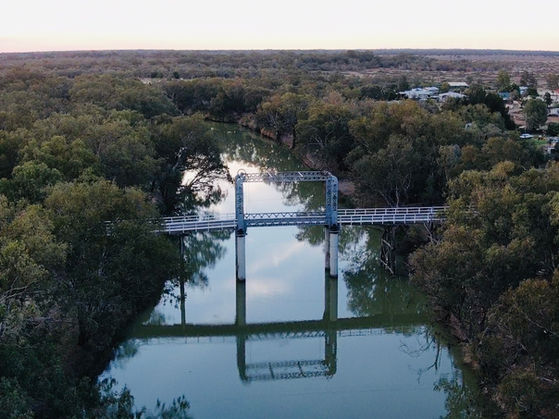
BREWARRINA
Set on the banks of the Barwon Darling River in the heart of outback NSW, the Brewarrina region is a place of deep cultural significance, ancient Dreaming stories and vast, rugged landscapes.
Step into 40,000 years of living culture.
At its heart lies Baiame’s Ngunnhu – the National Heritage-listed Brewarrina Fish Traps, believed to be the oldest known human construction on Earth. Ingeniously crafted over 40,000 years ago and still in use today, these remarkable stone traps stand as a powerful symbol of First Nations innovation, sustainability and spiritual connection to Country.
Discover stories passed down through generations, walk the riverbanks where tribes gathered and experience the enduring strength of culture and Country.
Beyond its rich heritage, Brewarrina offers stunning natural beauty – from peaceful riverside strolls and expansive outback vistas to unforgettable birdwatching and wildlife encounters.
Whether you seek adventure, connection or reflection, Brewarrina welcomes you.
Here, you’ll find history written in stone, stories carried on the wind and a community proud to share its past and present.
HISTORY AND CULTURE
Brewarrina is strongly grounded in its First Nations heritage. One of the most significant places in Eastern Australia, the National Heritage-listed Baiame’s Ngunnhu, or Brewarrina Fish Traps, are located right in the heart of Brewarrina. Believed to be the oldest human construction on Earth, the 40,000-year-old traps are still used today, and showcase the ingenuity of local First Nations people. Dreaming stories tell us the traps were built by the ancestral creator Baiame and his sons Boorna Ooma-Nowi and GhindaInda-Mui, who shaped them by casting Baiame’s net across the river. While the Ngemba people are custodians of the fishery, it is said Baiame commanded the traps be shared with other tribes and the area was one of the great meeting places for many nations, including the Morawari, Barkinji, Weilwan, Kamilaroi, Koamu, Valarai, Baranbinja, Wiradjuri, Ngemba and Yualwarri peoples who gathered here for food, ceremonies, trade and work. The traps remain a place of deep cultural, spiritual and social significance for First Nations communities. European settlement in the 1840s led to the town becoming a vital wool port on the Darling River. It was a hub for the Cobb & Co stagecoach company and developed as a crucial railway point in 1901, connecting the town to the wider region. The region today is still speckled with historic bridges, churches and buildings, monuments and wrecks from this period. The history of Brewarrina for First Nations people reflects the national pain experienced by Indigenous people due to colonisation in Australia. The Hospital Creek massacre and removal of people to the Brewarrina Aboriginal Mission are two important reminders of this pain. Discover more about the history, culture and connection to Country for this region by visiting the Brewarrina Aboriginal Cultural Museum. History and culture also run deep in the villages of the Brewarrina Shire. Angledool | Gongolgon | Goodooga | Weilmoringle Established in the late 1800s, on the eastern edge of the Shire is Angledool. Step back in time in this old opal mining village and discover buildings more than 120 years old. The old domed-roof town hall is uniquely made from local mud bricks. An incredible 900-carat black opal, dubbed the Fire Queen, was found here over 120 years ago. Originally sold for just £100, it could be worth over $10 million today. The quaint and picturesque village of Gongolgon was a former stop on the famous Cobb and Co trail. Twice a week, two horse coaches met with the Cobb and Co coach at Gongolgon to pick up passengers travelling to Brewarrina and further north. The last coach ran in 1923, no longer able to compete with the railway. Nestled in the heart of the outback, with vast open skies and striking red earth is Goodooga. The region holds significant First Nations cultural heritage for the Yuwaalaraay and Murrawarri peoples. It was home to the "Tin Camp" Aboriginal reserve, once containing 52 homes and two Aboriginal cemeteries. Traditional Owners and affiliated family groups continue to hold a strong cultural connection to these important sites. The Goodooga area was also once a hiding place for notorious bushranger Captain Thunderbolt, who was know for robbing inns and mail coaches in the 1860s. Wielmoringle is home of the Murrawarri people, who have been deeply connected to the Weilmoringle lands for thousands of years. Traditional campsites, artefacts and scarred trees can still be found nearby.
DIRECTIONS

BREWARRINA VISITOR INFORMATION CENTRE
02 6830 5152

.jpg)






